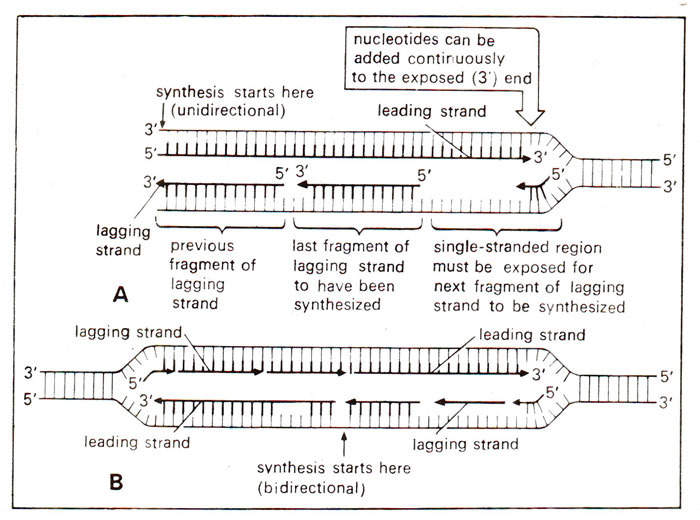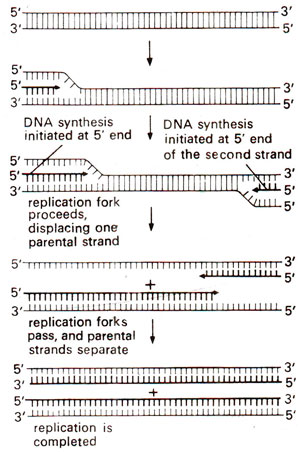
Fig. 26.6. Semi-discontinuous DNA replication under conditions of (A) unidirectional replication, (B) bidirectional replication.
A. Kornberg initially characterized an enzyme, now called
DNA polymerase I and believed it to be responsible for DNA-replication. However, later it was shown that this enzyme is mainly involved in DNA repair and not in DNA replication. Another enzyme
DNA polymerase III is now known to be responsible for DNA replication and synthesizes DNA in 5'→3' direction. Since the two strands of DNA have opposite polarities, DNA synthesis can not proceed on both strands, utilizing same enzyme, unless the synthesis proceeds in pieces. Such pieces called Okazaki
pieces (after the name of discoverer) have actually been observed and it is established that DNA synthesis is discontinuous on one of the two strands and the segments later get fused with the help of
ligase enzyme (Fig. 26.6).

Fig. 26.6. Semi-discontinuous DNA replication under conditions of (A) unidirectional replication, (B) bidirectional replication.
At one time, it was felt that there was enough evidence to suggest that DNA synthesis is discontinuous on both the strands. However, now it is known that DNA synthesis is continuous on one strand and discontinuous on the other strand (Fig. 26.6). When the double helix of DNA unwinds, DNA replication on one of the two strands (3' to 5' stand) can easily proceed continuously in 5' to 3' direction. This is the
leading strand. On the other strand (5'-3') if the synthesis has to take place in 5' to 3' direction, it has to be synthesized in a direction opposite to that on the leading strand. This strand is the
lagging strand and on this strand, synthesis takes place in segments discontinuously and these segments are then fused to create an intact lagging strand. This behaviour where the leading strand is synthesized continuously and the lagging strand is synthesized discontinuously is called semi-discontinuous replication.

Fig. 26.7. Continuous DNA replication on both strands initiated independently at the two ends (as observed in adenovirus).
In certain viruses like
adenovirus or Φ29, linear DNA replicates from the two ends by strand . displacement, so that both strands can be copied in 5' to 3' direction simultaneously without any need for discontinuous replication (Fig. 26.7). Therefore, it is obvious that semi-discontinuous replication is the result of a need to synthesize both strands simultaneously from the same origin.

Fig. 26.7. Continuous DNA replication on both strands initiated independently at the two ends (as observed in adenovirus).







